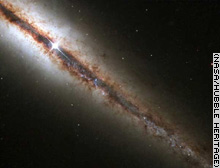Despite everything: Newton was right! Astronomy's "big sky survey" reveals: many galaxies are immersed in halos of dark mass
Dr. Noah Brosh

The first results from the big sky survey of astronomy, published at a conference in the Canary Islands, show that gravity at great distances "behaves" according to Newton's theory - and not as the physicist Prof. Mordechai Milgrom of the Weizmann Institute tries to propose, as a correction to this theory.
The astronomical survey shows that many smaller galaxies are immersed in large dark mass halos. About three decades ago, astronomers determined that there is a dark mass in the universe, which attracts other masses of matter that do not emit light. The discovery was based on measuring the rotation speed of the galaxies, around themselves.
Galaxies are collections of stars and gas. Some of it is in luminous nebulae - therefore it can be seen easily. Inside the galaxy, the rotation speed does not decrease with distance from the center of the galaxy, but remains constant. However, the light intensity (of the stars) decreases with distance. The Newtonian gravitation theory from the 18th century dictates the dependence of force on distance. If the mass in the galaxies corresponds to light - then beyond the visible limit of the galaxy, the mass ends, and from there on, every small body will move in the depths of space as if the mass of the galaxy is concentrated in its center. As is the case with the planets orbiting the Sun. The speed of their movement decreases as their distance from the sun increases. The scientists expected to find this phenomenon in all galaxies.
But here a problem arose - and its solution was proposed in two directions. One - adding mass to the galaxy, without adding light (the dark mass). The second - a change in the wording of the law of gravity, so that its strength, at great distances, will decrease more slowly than the square of the distance. This solution was proposed by Prof. Milgrom under the name "Change of Newtonian dynamics".
And now, based on the new results from the analysis of long-term measurements, in the "Sloan Salon Survey", in which a special telescope photographed the entire northern sky and measured the speeds of galaxies - it became clear that there is no room, at least for now, for Prof. Milgrom's solution. The researchers, led by Francisco Prada, measured the velocity distribution of about 3000 galaxies accompanying bright galaxies. The "satellites" are similar to the planets in our solar system. Their movement is affected by the gravitational force of the central galaxy that they surround.
The regions near the main galaxies, where the satellites are located, are very distant from the main galaxies. The study of motion examined the dependence of gravity on distance, beyond the boundaries of galaxies. The researchers found that the speed of the "satellites", as they move away from the main galaxy they orbit, is done in accordance with the prediction of the dark mass, in addition to the luminous mass of the galaxies - and not as suggested by Prof. Milgrom.
The discoveries of the last year show that the luminous matter constitutes only 4% of the contents of the universe. The dark mass 23% and the rest - about three quarters of what the universe contains - is "dark energy" whose origin is still unknown.
